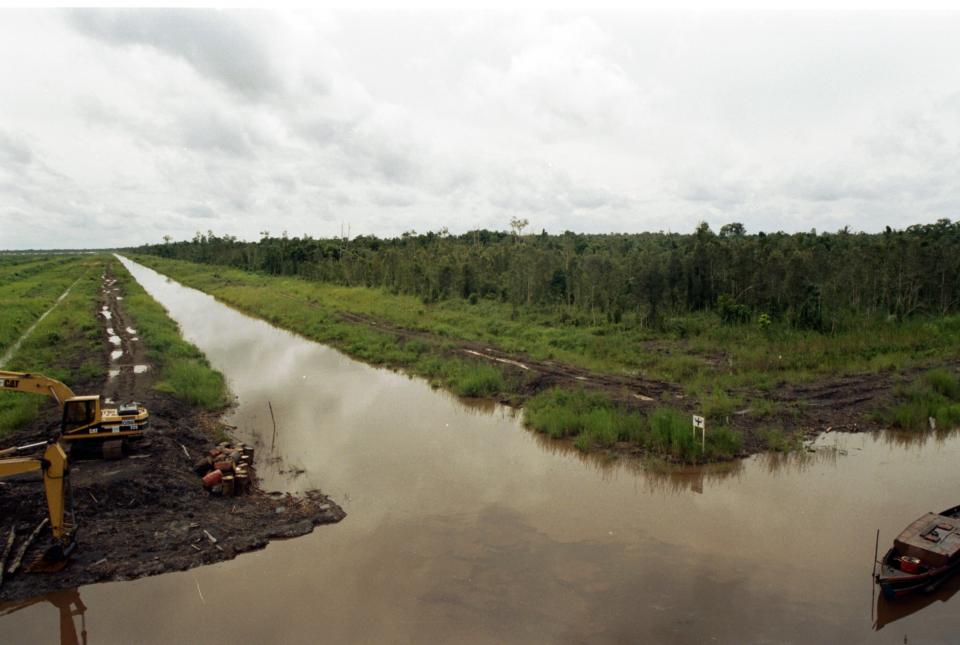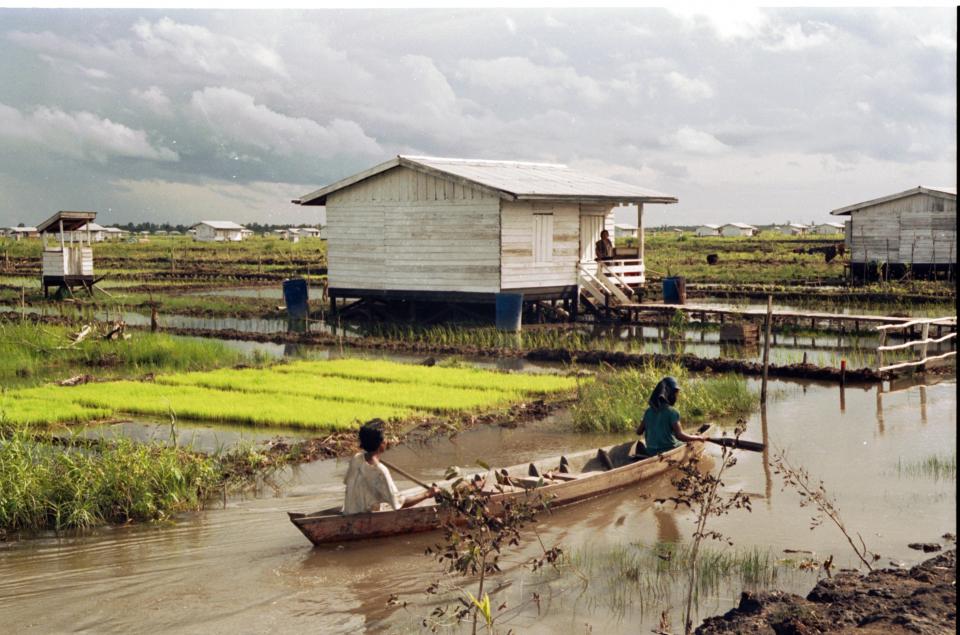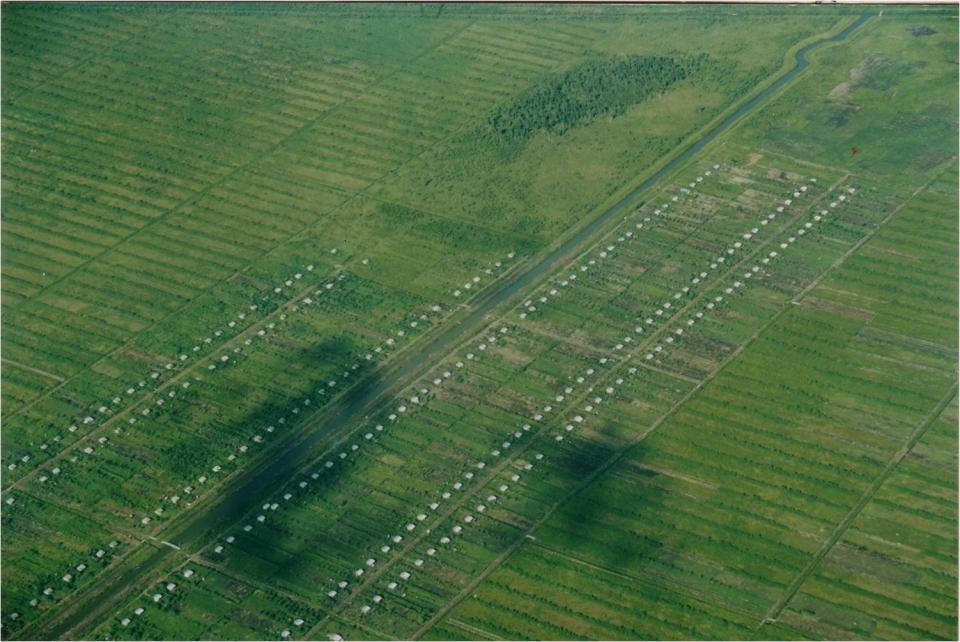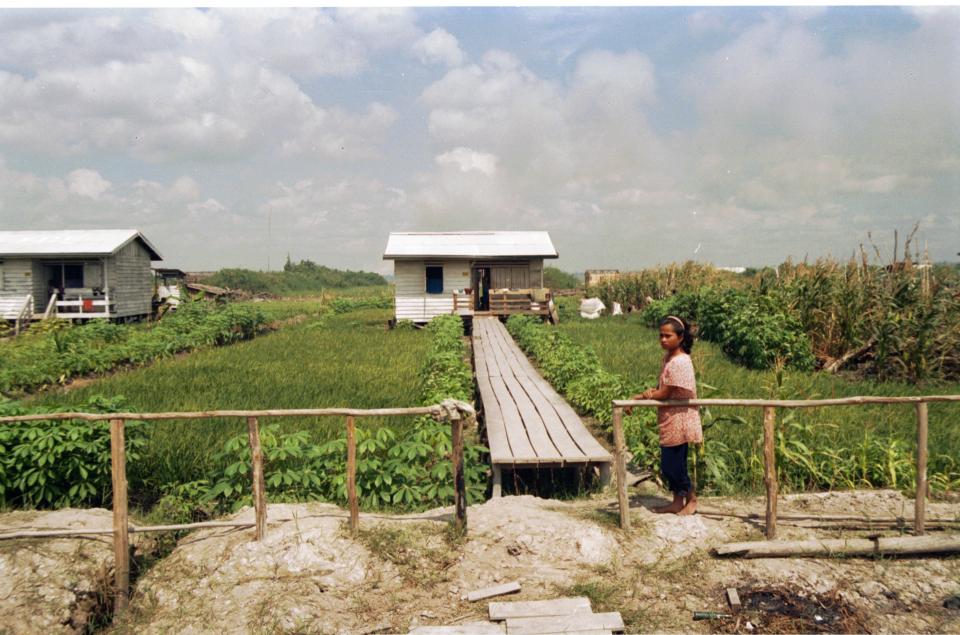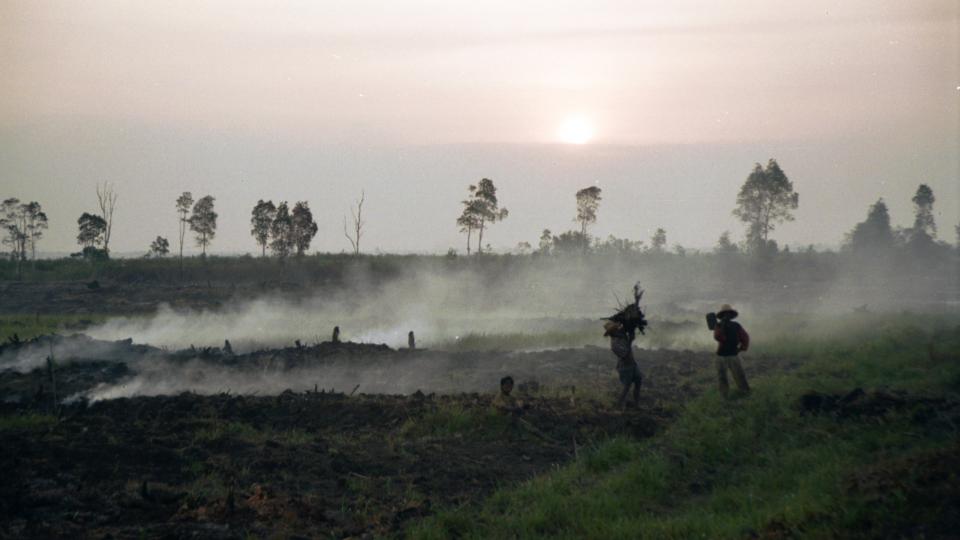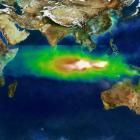In late 1997 and into 1998, the peat swamp forests in Central Kalimantan, Indonesia, on the island of Borneo erupted in flames, sending plumes of smoke over Sumatra, Singapore, and Malaysia. Although the fires in the swamps of Central Kalimantan were among the worst, peatlands and forests caught fire across Indonesian Borneo and Sumatra that year. According to some scientists’ estimates, the amount of carbon dioxide that Indonesia’s fires spewed into the atmosphere in late 1997 was equivalent to somewhere between 13 and 40 percent of global annual carbon emissions from fossil fuels. Coinciding with the overthrow of Indonesian President Suharto, the Asian economic crisis, and an especially dry El Niño year, 1998’s perfect storm of environmental and political upheaval thrust Indonesia’s peat swamp forests into national and global consciousness.
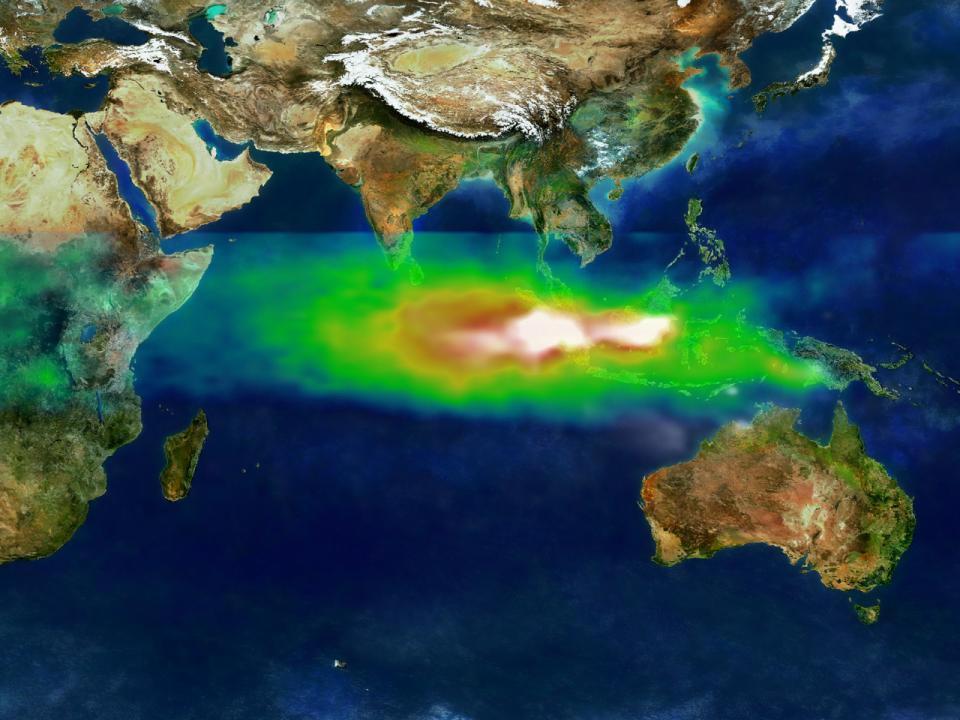
NASA imagery of pollution plume over Indian Ocean from Indonesian fires, 22 October 1997
NASA imagery of pollution plume over Indian Ocean from Indonesian fires, 22 October 1997
Image courtesy NASA GSFC Scientific Visualization Studio, based on data from TOMS.
Click here to view Visible Earth source.
This work is used by permission of the copyright holder.
At the center of this environmental crisis was the Mega Rice Project. In the early 1990s, President Suharto envisioned the peat swamps of Central Kalimantan as the ideal landscape for a project establishing intensive, Javanese-style wet rice production, which was aimed to bolster Indonesia’s fledging food self-sufficiency and feed the country’s 200 million people. While indigenous groups in coastal Kalimantan had long cultivated rice using tidal irrigation, this native farming system was far different from the irrigated paddy rice cultivation found in Java. However, the densely populated island of Java, Indonesia’s political center and fertile proverbial breadbasket, was losing rice paddies to industrial development. Suharto’s administration looked to offset declining rice production by opening new agricultural land in Indonesia’s “outer islands,” or all of the islands beyond Java and Bali.
A Singapore-based agribusiness company, PT Sambu, boasted of success in growing coconuts and pineapples commercially in the peatlands of southeastern Sumatra by relying on an elaborate network of dikes and canals to control tidal flooding. Despite the fact that the ecosystems of Sumatra and Central Kalimantan are not analogous, the businessmen talked Suharto into planning intensive wet-rice cultivation in Kalimantan based on the fact that they had successfully cultivated peatlands commercially. They were later appointed as contractors in the Mega Rice Project. Scientists and engineers from several prominent Indonesian universities were commissioned to design pieces of the project’s canal-based infrastructure, though Suharto and his advisors sought little input from experts regarding the project’s potential for success at the grand scale they imagined it. Some Indonesian and foreign scientists quietly thought that the Mega Rice Project would never work but few dared to speak out against President Suharto, a harsh silencer of critics during his 35-year reign.
Canal construction began abruptly in late January of 1996. During 1996 and through 1997, the Ministry of Public Works, with support from the Ministries of Transmigration, Forestry, and Agriculture, coordinated several thousand Japanese-made excavators and tens of thousands of workers to dig 6,000 kilometers of canals and clear vegetation across one million hectares of peat swamp forest. As part of Indonesia’s long-running transmigration program, roughly 40,000 Javanese and Balinese farmers were each given 2.5 hectares of land to transform the deep, acidic peat soil into lush agricultural fields for wet rice cultivation. Few of these transmigrants harvested much rice, however. The nutrient-poor peat soils were ultimately unforgiving, and most Javanese and Balinese farmers were ill-prepared for this peatland ecosystem. Despite the project’s reliance on smallholder farmers, the Mega Rice Project was foremost a failed commercial scheme. Government planners had vastly overestimated the extent to which small farmers could manage a complex ecological system.
In late 1997, after a year of drought induced by a strong El Niño/Southern Oscillation cycle, fires started burning underground, through the peat soil itself. Tropical peat soil is volatile organic matter composed of decomposing tree trunks, leaves, and roots. Left undisturbed, the soils lie at the bottom of forested, waterlogged swamps throughout the tropics at depths ranging from less than one meter to over 15 meters. Carbon is highly concentrated in peat soil and is relatively stable if the soil is saturated with water. But when tropical peatlands are drained across a large hydrological area, as they were in the Mega Rice Project, the soil undergoes rapid biogeochemical oxidation, emitting vast amounts of carbon dioxide into the atmosphere.
The project is now referred to as one of the biggest environmental disasters in Indonesia’s history, not only because it enabled massive peat fires but also because the project—the objective of which was large-scale irrigated rice cultivation in the peat swamps—produced almost no rice. Following the failure of the Mega Rice Project and the unprecedented peat fires, a coalition of foreign and Indonesian scientists mobilized to conduct extensive research on the greenhouse gas storage and emissions capability of tropical peat soil. This data-based knowledge, reflecting the international priority for climate change research in the twenty-first century, reconceptualized the peatland landscape as a significant carbon source and thus a global environmental risk.
How to cite
Goldstein, Jenny. “Carbon Bomb: Indonesia’s Failed Mega Rice Project.” Environment & Society Portal, Arcadia (Spring 2016), no. 6. Rachel Carson Center for Environment and Society. https://doi.org/10.5282/rcc/7474.
ISSN 2199-3408
Environment & Society Portal, Arcadia
 This work is licensed under a Creative Commons Attribution-NonCommercial-ShareAlike 4.0 International License.
This work is licensed under a Creative Commons Attribution-NonCommercial-ShareAlike 4.0 International License.
2016 Jenny Goldstein
This refers only to the text and does not include any image rights.
Please click on an image to view its individual rights status.
- Bray, Francesca, Peter A. Coclanis, Edda L. Fields-Black, and Dagmar Schäefer. Rice: Global Networks and New Histories. New York: University of Cambridge Press, 2015.
- Galudra, Gamma, M. van Noordwijk, Idris Sardi, U. Pradhan, and D. Catacutan. Hot Spot of Emission and Confusion: Land Tenure Insecurity, Contested Policies and Competing Claims in the Central Kalimantan Ex-Mega Rice Project Area. Bogor, Indonesia: World Agroforestry Center, 2010.
- Goldstein, Jenny E. “Knowing the Subterranean: Land Grabbing, Oil Palm, and Divergent Expertise in Indonesia's Peat Soil.” Environment and Planning A 48, no. 4 (2016): 756–770.
- Harwell, Emily. “Remote Sensibilities: Discourses of Technology and the Making of Indonesia's Natural Disaster.” Development and Change 31 (2000): 307–340.
- Maat, Harro. “Agriculture in Indonesia”. In Encyclopaedia of the History of Science, Technology, and Medicine in Non-Western Cultures. Dordrecht: Springer Science+Business Media, 2014, 1–5. Accessed 20 April 2015. doi: 10.1007/978-94-007-3934-5_10229-1.
- McCarthy, John. “Tenure and Transformation in Central Kalimantan: After the ‘Million Hectare’ Project.” In Land for the People: The State and Agrarian Conflict in Indonesia, edited by Anton Lucas, and Carol Warren, 183–214. Athens, OH: Ohio University Press, 2013.
- Moon, Suzanne. “Takeoff or Self-Sufficiency? Ideologies of Development in Indonesia, 1957–1961.” Technology and Culture 39 (1998): 187–212.


